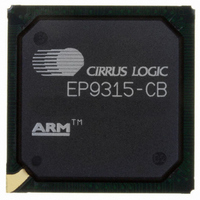EP9315-CB Cirrus Logic Inc, EP9315-CB Datasheet - Page 309

EP9315-CB
Manufacturer Part Number
EP9315-CB
Description
IC ARM920T MCU 200MHZ 352-PBGA
Manufacturer
Cirrus Logic Inc
Series
EP9r
Specifications of EP9315-CB
Core Processor
ARM9
Core Size
16/32-Bit
Speed
200MHz
Connectivity
EBI/EMI, EIDE, Ethernet, I²C, IrDA, Keypad/Touchscreen, PCMCIA, SPI, UART/USART, USB
Peripherals
AC'97, DMA, I²:S, LCD, LED, MaverickKey, POR, PWM, WDT
Number Of I /o
16
Program Memory Type
ROMless
Ram Size
32K x 8
Voltage - Supply (vcc/vdd)
1.65 V ~ 3.6 V
Data Converters
A/D 8x12b
Oscillator Type
External
Operating Temperature
0°C ~ 70°C
Package / Case
352-BGA
Processor Series
EP93xx
Core
ARM920T
Data Bus Width
32 bit
3rd Party Development Tools
MDK-ARM, RL-ARM, ULINK2
Development Tools By Supplier
EDB9315A-Z
For Use With
598-1144 - KIT DEVELOPMENT EP9315 ARM9
Lead Free Status / RoHS Status
Contains lead / RoHS non-compliant
Eeprom Size
-
Program Memory Size
-
Lead Free Status / Rohs Status
No
Other names
598-1261
Available stocks
Company
Part Number
Manufacturer
Quantity
Price
Part Number:
EP9315-CBZ
Manufacturer:
CIRRUS
Quantity:
20 000
- Current page: 309 of 824
- Download datasheet (13Mb)
DS785UM1
9.1.4 Transmit Back-Off
9.1.4.1 Transmission
9.1.4.2 The FCS Field
Refer to
there is a collision. There are two kinds of collision: normal collision (one that occurs within
the first 512 bits of the packet) and late collision (one that occurs after the first 512 bits). In
either collision type, the MAC engine always sends a 32 bit jam sequence, and stops
transmission.
After a normal collision and the jam, transmission is stopped, or “backed-off”. The MAC
attempts transmission again according to one of two algorithms. The ISO/IEC standard
algorithm or a modified back-off algorithm may be used, and the host chooses which
algorithm through the ModBackoffE control bit (TXCtl). The standard algorithm from ISO/IEC
paragraph 4.2.3.2.5 is called the “truncated binary exponential backoff” and is shown below:
where r is a random integer for the number of slot times the MAC waits before attempting
another transmission, and a slot time is time of 512 bits (51.2 μsec), k = minimum (n,10), and
n is the nth retransmission attempt. The modified back-off algorithm uses delays longer than
the ISO/IEC standard after each of the first three transmit collisions as shown below:
where k = minimum (n,10), but not less than 3, and n is the nth retransmission attempt
The advantage of the modified algorithm over the standard algorithm is that the modification
reduces the possibility of multiple collisions on any transmission attempt. The disadvantage is
that the modification extends the maximum time needed to acquire access to the medium.
The host may choose to disable the back-off algorithm altogether. This is done through the
control bit DisableBackoff (TestCtl). When set, the MAC transmitter waits for the Inter Frame
Gap time before starting transmission. There is no back-off algorithm employed. When clear,
the MAC uses either the standard or the modified algorithm.
After the transmission has passed the time for a normal collision (512 bits), then transmission
is either completed, or aborted due to a late collision. For a late collision, the transmitter
sends the 32 bit jam sequence, but does not back-off and try again. When a late collision
occurs, Out-of-wdw collision (XStatQ) is set. A late collision is not retried, because the first 64
bytes of the FIFO are freed after the normal collision window, and will likely be refilled by a
following packet. Driver intervention is needed to reconstruct the FIFO data.
If InhibitCRC (Transmit Descriptor) is clear, the MAC automatically appends the standard 32
bit FCS to the end of the frame. The MAC tests the last 32 bits received against the standard
CRC computation. If received in error, CRCerror (RStatQ) is set. If CRCerroriE (Interrupt
Enable) is set, there is an interrupt associated with CRCerror. The standard CRC conforms to
ISO/IEC 8802-3 section 3.2.8. The polynomial for the CRC is:
G(x) = x
32
Figure
+ x
26
+ x
9-3. Once transmission is started, either the transmission is completed, or
23
+ x
22
+ x
16
Copyright 2007 Cirrus Logic
+ x
0 <= r <= 2
0 <= r <= 2
12
+ x
11
+ x
k
k
10
+ x
8
+ x
7
+ x
1/10/100 Mbps Ethernet LAN Controller
5
+ x
4
+ x
2
+ x + 1
EP93xx User’s Guide
9-7
9
Related parts for EP9315-CB
Image
Part Number
Description
Manufacturer
Datasheet
Request
R

Part Number:
Description:
IC ARM9 SOC ENH UNIV 352PBGA
Manufacturer:
Cirrus Logic Inc
Datasheet:

Part Number:
Description:
32-Bit Microcontroller IC
Manufacturer:
Cirrus Logic Inc
Datasheet:

Part Number:
Description:
IC ARM920T MCU 200MHZ 352-PBGA
Manufacturer:
Cirrus Logic Inc
Datasheet:

Part Number:
Description:
MCU, MPU & DSP Development Tools Eval Bd Uni. ARM9 SOC Processor
Manufacturer:
Cirrus Logic Inc
Datasheet:

Part Number:
Description:
IC ARM920T MCU 166MHZ 208-LQFP
Manufacturer:
Cirrus Logic Inc
Datasheet:

Part Number:
Description:
IC ARM920T MCU 200MHZ 352-PBGA
Manufacturer:
Cirrus Logic Inc
Datasheet:

Part Number:
Description:
IC ARM920T MCU 166MHZ 208-LQFP
Manufacturer:
Cirrus Logic Inc
Datasheet:

Part Number:
Description:
Development Kit
Manufacturer:
Cirrus Logic Inc
Datasheet:

Part Number:
Description:
Development Kit
Manufacturer:
Cirrus Logic Inc
Datasheet:

Part Number:
Description:
High-efficiency PFC + Fluorescent Lamp Driver Reference Design
Manufacturer:
Cirrus Logic Inc
Datasheet:

Part Number:
Description:
Development Kit
Manufacturer:
Cirrus Logic Inc
Datasheet:

Part Number:
Description:
Development Kit
Manufacturer:
Cirrus Logic Inc
Datasheet:

Part Number:
Description:
Development Kit
Manufacturer:
Cirrus Logic Inc
Datasheet:

Part Number:
Description:
Ref Bd For Speakerbar MSA & DSP Products
Manufacturer:
Cirrus Logic Inc












